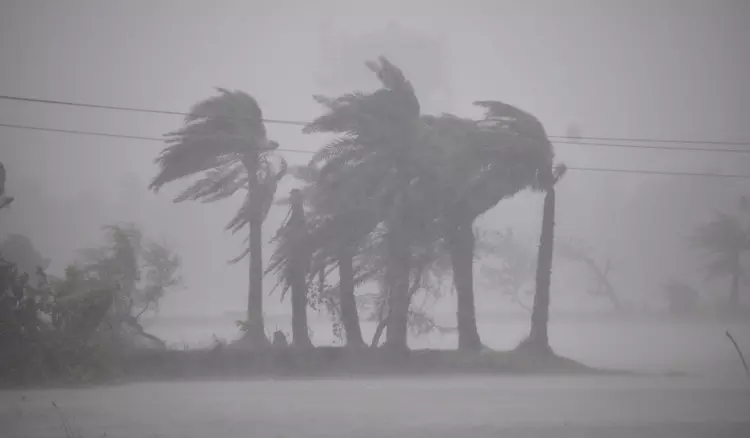September-October Emerge As Cyclone Hotspot Months for AP

Cyclones have significantly impacted Andhra Pradesh, with 60 storms, including 40 very severe, hitting the state between 1970 and 2022. (DC File Image)
VISHAKHAPATNAM: Andhra Pradesh has faced major havocs from cyclones over the past five decades, with a staggering total of 60 hits recorded, 40 of them ‘very severe’.
According to data from the AP Disaster Management Authority, 24 of these cyclonic activity occurred between the months of September and December. The impact of these cyclones has been devastating, taking a total of 147 human lives.
In September, 2018, cyclonic storm DAYE hit the state’s northern region. Cyclone Gulab, which came calling in Sept 2021, impacted six districts. The deadliest Sept cyclone was in 2005, killing 105 persons and ravaging 10 districts.
October cyclones have also been severe. The ‘very severe cyclonic storm’ TITLI in 2018 affected eight districts. Cyclone Hud Hud in 2014 impacted four districts and seriously affected around 92.78 lakh people. It caused 63 deaths. Other cyclonic events include Cyclone Phailin in 2013 and Ogni in 2006.
November has brought its share of challenges as well. The ‘very severe cyclonic storm Nivar in 2020 impacted six districts, while cyclone Helen in 2013 caused nine deaths across ten districts. Other storms like Nilam in 2012 and Jal in 2010 left a toll of 64 deaths across 13 districts.
December cyclones have not spared the state either. In 2022, cyclonic storm Mandodus affected six districts.
Historical data shows that ‘severe cyclonic storm’ Phethai (2018), Vardah (2016), and Thane (2011) wreaked havoc across AP’s coastal districts. Thane took a toll of 64 deaths.
AP’s history of cyclones dates back to the 1970s. In Sept1971, a severe cyclonic storm struck the coast near Srikakulam, followed by another in the same month, affecting the north coastal Andhra region.
One of the most infamous cyclones to hit the state was the 1977 Diviseema Cyclone, which devastated the coast from Srikakulam to Guntur, causing widespread destruction. AP coast continued to witness cyclonic activity throughout the 1980s and 1990s, with the 1999 Odisha cyclone also hitting the state with severe intensity.
Stella S, director of national weather tracking agency IMD in Amaravati bureau, noted that no cyclonic activity said no cyclonic activity is expected for at least two weeks now.
She explained why Andhra Pradesh frequently faces cyclones between September and December. “The movement of the Intertropical Convergence Zone (ITCZ), favourable sea surface temperatures above 26.5°C and vorticity play a crucial role in cyclone formation. These conditions are particularly conducive after the monsoon withdraws, when the sea’s surface temperatures peak, leading to the creation of low-pressure systems that can intensify into cyclones.”
P. Sunitha, a professor of meteorology, said cyclones often form within 45 days of the monsoon’s retreat. “The warming of the Bay of Bengal during October leads to evaporation and moisture build-up, creating ideal conditions for the cyclonic development.”
In September, 2018, cyclonic storm DAYE hit the state’s northern region. Cyclone Gulab, which came calling in Sept 2021, impacted six districts. The deadliest Sept cyclone was in 2005, killing 105 persons and ravaging 10 districts.
October cyclones have also been severe. The ‘very severe cyclonic storm’ TITLI in 2018 affected eight districts. Cyclone Hud Hud in 2014 impacted four districts and seriously affected around 92.78 lakh people. It caused 63 deaths. Other cyclonic events include Cyclone Phailin in 2013 and Ogni in 2006.
November has brought its share of challenges as well. The ‘very severe cyclonic storm Nivar in 2020 impacted six districts, while cyclone Helen in 2013 caused nine deaths across ten districts. Other storms like Nilam in 2012 and Jal in 2010 left a toll of 64 deaths across 13 districts.
December cyclones have not spared the state either. In 2022, cyclonic storm Mandodus affected six districts.
Historical data shows that ‘severe cyclonic storm’ Phethai (2018), Vardah (2016), and Thane (2011) wreaked havoc across AP’s coastal districts. Thane took a toll of 64 deaths.
AP’s history of cyclones dates back to the 1970s. In Sept1971, a severe cyclonic storm struck the coast near Srikakulam, followed by another in the same month, affecting the north coastal Andhra region.
One of the most infamous cyclones to hit the state was the 1977 Diviseema Cyclone, which devastated the coast from Srikakulam to Guntur, causing widespread destruction. AP coast continued to witness cyclonic activity throughout the 1980s and 1990s, with the 1999 Odisha cyclone also hitting the state with severe intensity.
Stella S, director of national weather tracking agency IMD in Amaravati bureau, noted that no cyclonic activity said no cyclonic activity is expected for at least two weeks now.
She explained why Andhra Pradesh frequently faces cyclones between September and December. “The movement of the Intertropical Convergence Zone (ITCZ), favourable sea surface temperatures above 26.5°C and vorticity play a crucial role in cyclone formation. These conditions are particularly conducive after the monsoon withdraws, when the sea’s surface temperatures peak, leading to the creation of low-pressure systems that can intensify into cyclones.”
P. Sunitha, a professor of meteorology, said cyclones often form within 45 days of the monsoon’s retreat. “The warming of the Bay of Bengal during October leads to evaporation and moisture build-up, creating ideal conditions for the cyclonic development.”
( Source : Deccan Chronicle )
Next Story

